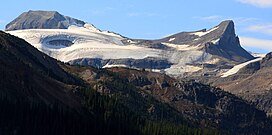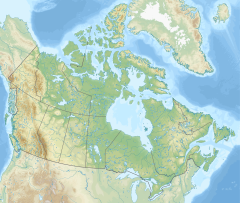| Mount Olive | |
|---|---|
 Mount Olive (left) with Saint Nicholas Peak (right) seen from Bow Lake Mount Olive (left) with Saint Nicholas Peak (right) seen from Bow Lake | |
| Highest point | |
| Elevation | 3,126 m (10,256 ft) |
| Prominence | 146 m (479 ft) |
| Listing | |
| Coordinates | 51°36′40″N 116°29′30″W / 51.61111°N 116.49167°W / 51.61111; -116.49167 |
| Geography | |
   | |
| Country | Canada |
| Provinces | Alberta and British Columbia |
| Protected areas | |
| Parent range | Park Ranges Canadian Rockies |
| Topo map | NTS 82N9 Hector Lake |
| Climbing | |
| First ascent | 1927 M. Cropley, F.A. Gambs, N.L. Goodrich, L. Grassi |
Mount Olive is located N of the head of the Yoho River on the Continental Divide, on the Alberta-British Columbia border, in both Banff National Park and Yoho National Park. It lies on the eastern edge of the Wapta Icefield, and is part of the Waputik Mountains. It was named in 1898 by H.B. Dixon after his wife Dixon, Olive.
Geology
The peak is composed of sedimentary rock laid down during the Precambrian to Jurassic periods. Formed in shallow seas, this sedimentary rock was pushed east and over the top of younger rock during the Laramide orogeny.
Climate
Based on the Köppen climate classification, it is located in a subarctic climate with cold, snowy winters, and mild summers. Temperatures can drop below -20 °C with wind chill factors below -30 °C.
See also
Further reading
- Birrell, Dave (2000). 50 Roadside Panoramas in the Canadian Rockies. Rocky Mountain Books. p. 51. ISBN 978-0-921102-65-6. Retrieved 2021-07-11.
References
- ^ "Mount Olive". cdnrockiesdatabases.ca. Retrieved 2019-06-07.
- ^ "Mount Olive". Bivouac.com. Retrieved 2019-06-07.
- ^ "Mount Olive (Alberta)". Geographical Names Data Base. Natural Resources Canada. Retrieved 2023-10-14.
- ^ "Mount Olive". BC Geographical Names. Retrieved 2023-10-14.
- Belyea, Helen R. (1960). The Story of the Mountains in Banff National Park (PDF). parkscanadahistory.com (Report). Ottawa: Geological Survey of Canada. Archived (PDF) from the original on 2015-10-02. Retrieved 2019-09-13.
- Gadd, Ben (2008). Geology of the Rocky Mountains and Columbias.
- Peel, M. C.; Finlayson, B. L.; McMahon, T. A. (2007). "Updated world map of the Köppen−Geiger climate classification". Hydrol. Earth Syst. Sci. 11 (5): 1633–1644. Bibcode:2007HESS...11.1633P. doi:10.5194/hess-11-1633-2007. ISSN 1027-5606.
This article related to a mountain, mountain range, or peak in Canada is a stub. You can help Misplaced Pages by expanding it. |
This Alberta's Rockies location article is a stub. You can help Misplaced Pages by expanding it. |
This article about a location in the Regional District of East Kootenay, Canada is a stub. You can help Misplaced Pages by expanding it. |